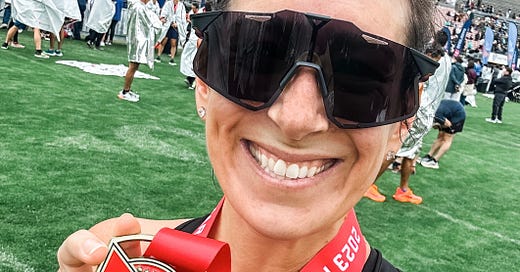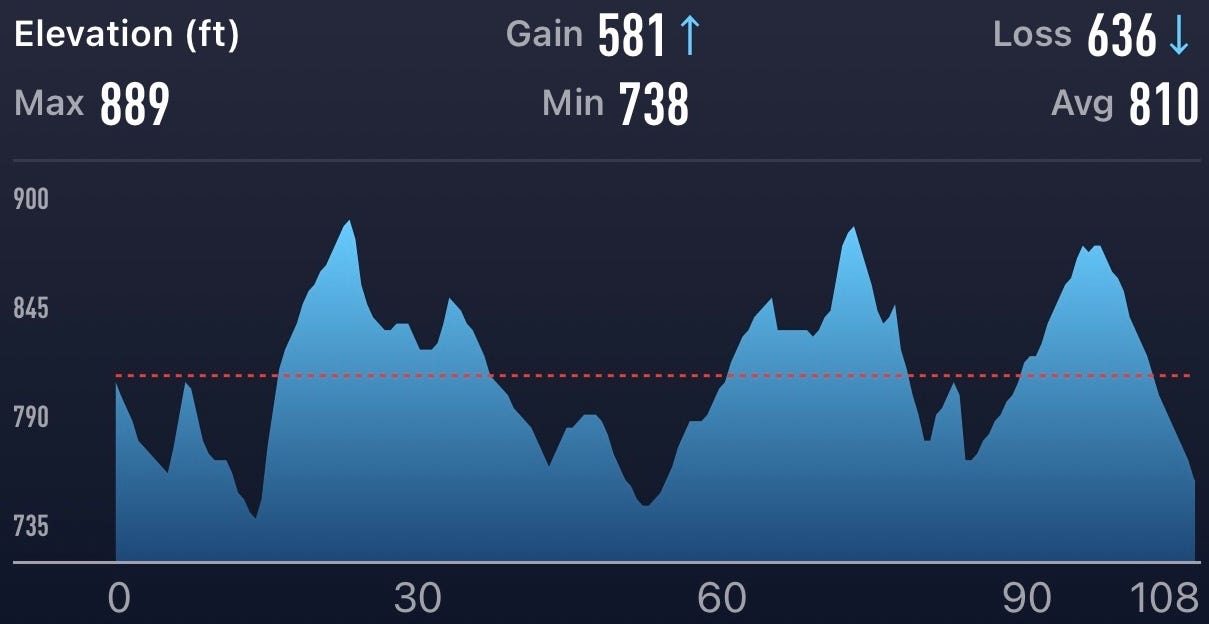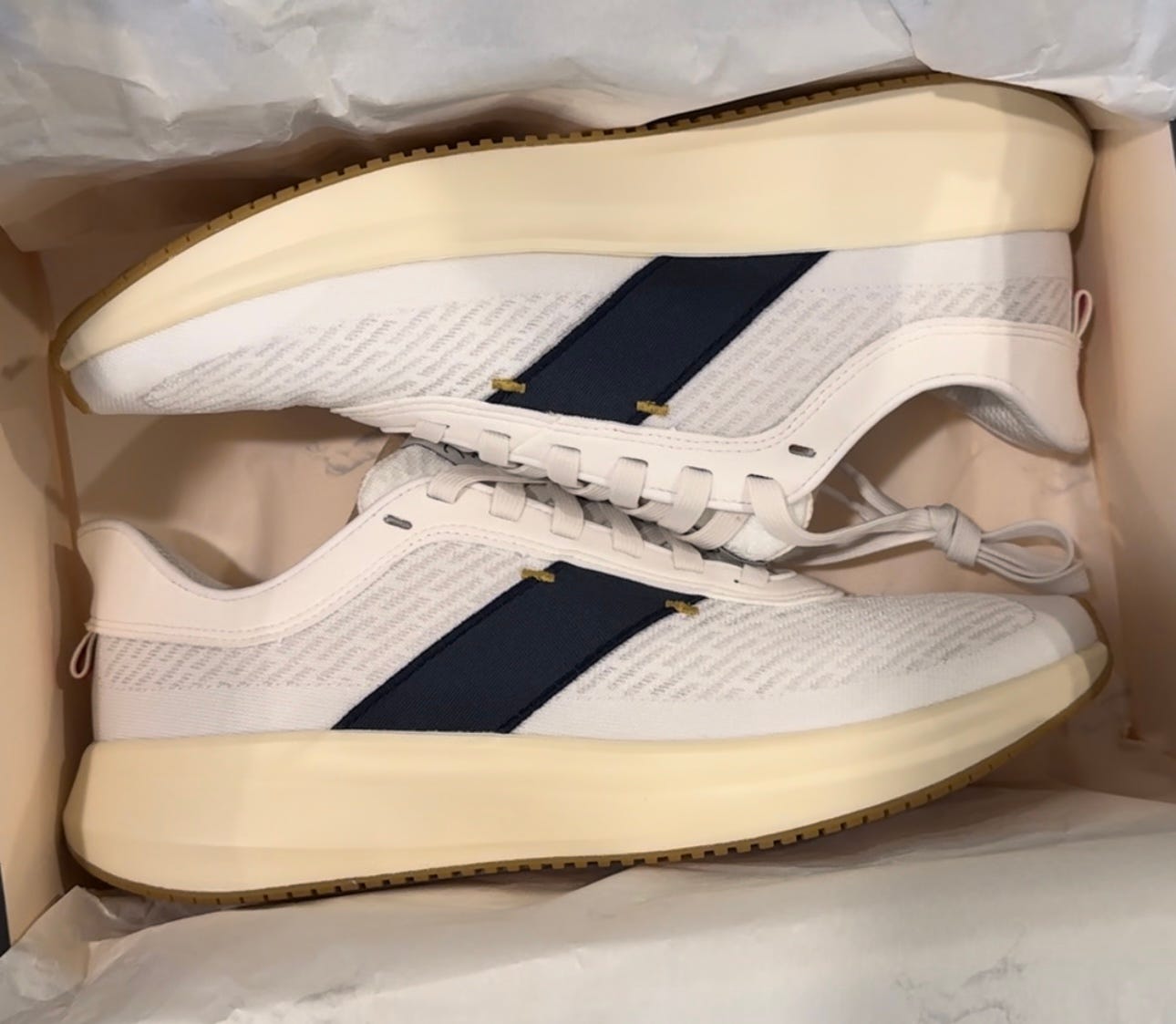What a racing weekend! While Emily Sisson was breaking her own American Record at the Houston Half Marathon and Ethiopia’s Yalemzerf Yehualaw nearly broke her own 10K world record in Valencia (while avoiding a chaotic pile-up at the starting line), I ran the Rose Bowl Half Marathon in Pasadena, CA.
I’d never heard of this race before, but with 50 days left until the Tokyo Marathon, it felt like a good way to escape Denver’s icy streets and get a quality long run workout in (at sea level, no less!). The weather didn’t exactly cooperate—California’s received record-setting heavy rain over the past few weeks—but it was around 50°F at the start line and misty rather than rainy, which was actually kind of ideal for racing.
My plan (courtesy of coach Matthew Meyer) was to do four miles at an easy warm-up pace (around 8:30-8:45), then pick it up to around 8:15 for six miles, and finish strong with three miles at sub-8:00. For extra credit—and to get my long run for the day to 16 miles—the plan was to cooldown with a run home. I’d only had about seven weeks of training post back-to-back fall marathons, so I was a little nervous about hitting those marks.
That didn’t quite go as planned: I of course went out a little hot, but then the hills (more on those in a second) reined me in and I was able to settle into a more comfortable pace, but I never saw anything over an 8:29…whoops. (If you’re into all the nitty-gritty pacing details, you can follow me on Strava). I kept the middle six miles at sub-marathon pace, but didn’t find my kick until the final mile, where I suddenly tapped into some insane second gear and ran my fastest mile of the entire race. I’m pretty sure this was the first race I’ve ever run negative splits, which was pretty cool!
Those hills, though. Woof. I didn’t do a lot of course research ahead of time, and I didn’t realize how many rolling hills there would be. The course starts at the Rose Bowl Stadium then climbs through residential neighborhoods for the first three miles. It was supposed to be “mostly” flat from there until mile nine, but there are three out-and-backs within those miles (which I actually loved, because it created more of a crowded feeling in a race where spectators were sparse), which definitely had slight ups and downs. And there were several super sharp downhills, which you’d think would be helpful but were actually so steep I had to slow down to avoid wiping out. The final 5K wraps around the stadium and features a steady decline before entering the stadium, with its mid-field finish line, which is pretty epic.
I opted to run in the new ASICS Superblast, which are like a Frankensteined version of the brand’s Novablast and Metaspeed. I’ve been happily running lots of long runs in these, so I wanted to see how they responded in a race environment. The verdict: They were super comfortable and I felt fast-ish, but I missed the pop I get from a carbon plate. So I’ll likely be racing Tokyo in the Metaspeed Sky 2. But! The Superblast will absolutely stay in the rotation for long run workouts; I like the idea of training hard in a non-plated shoe and saving that carbon magic for race day.
Honestly, I’m more proud of this race than I am of my half marathon PR (which took place on a course with over 2,000 feet of elevation loss). For starters, I have a bad habit of going into every race thinking I’m going to somehow PR—even when I’m not trained for a PR—so I’m glad I was able to keep my expectations in check and run this race strategically, instead of getting ahead of myself and blowing up halfway through. Plus, I’m notorious for avoiding hills in training (Tokyo is flat!!), and despite the fact that this race had 581 feet of elevation gain, I managed to power up every incline without losing too much steam. And I’m pretty sure I’ve walked in every race I’ve run, so when I started feeling the fatigue around mile 11 on Sunday, I decided the only goal I cared about at that point was not walking—and I didn’t! Hooray for non-PR goals.
At this point, I’m not 100 percent sure I can sustain an effort like this for another 13.1 miles, but I’m going to trust my training (seven more weeks!) and be grateful that the Tokyo Marathon has only 198 feet of gain.
the rundown
Running.The Show Podcast
I’m really excited about this podcast delving into the business side of running. The first episode introduced hosts Drew Hartman (a marketer at Tracksmith), Em Kertesz (a sub-elite runner), and Evan Schwartz (a running coach), and their goals for the pod, from discussing athlete salary transparency to how track and field can capitalize on its fandom. I’m also interested in hearing them talk to runners, coaches, and club leaders about how they navigate the intersection of branding, performance, and community; origin stories from smaller brands; and from people working specific roles (like color design, for example) within larger companies.
Kipchoge Is Running Boston
I’m so glad I’m traveling to Boston to spectate the Marathon this year, because Eliud Kipchoge is finally running it. “So far, my preparations are going on well and I am really looking forward to run a good race,” he told Captol Sports. He also shared his motivation: “The reason number one I am excited is because this year will be the 10th anniversary of the bomb attack in Boston and I feel I should be there to be with them at this time and also send positive vibes around the world and show that we are brothers and sisters.” But I thiiink he also wants his fifth marathon major win, since he’s aiming to become the first man to win all six.
Tracksmith Eliot Runner
OK, I know $198 is a lot for a daily trainer. But people are psyched about the first running shoe from Tracksmith, and for good reason. There’s no doubt this shoe looks fresh, but it’s not easy for an apparel brand to venture into performance footwear and I was skeptical as to how it would fare on the run. But I loved it. The midsole and insole are both made of Pebax (the same foam that’s found in racing shoes like the Nike Vaporfly/Alphafly), but the former is firmer and more responsive while the latter is much cushier (it’s three times thicker than traditional insoles). I thought the two layers balanced each other out nicely; I could pick up the pace if I wanted to, but I also felt like I could run at an easy effort forever. (Of course, I promptly ruined them in Denver’s snow.)
What Causes Muscle Cramping?
Cramping is kind of a running mystery, in that most runners have experienced it at some point or another but we still don’t know what exactly causes it. While marathon runners didn’t display a greater degree of dehydration and electrolyte depletion in a study published in a 2022 study published in the Journal of Strength and Conditioning Research, they did exhibit higher concentrations of muscle damage biomarkers (i.e. creatine kinase). Interestingly, more non-crampers included strength training—which may mean their bodies were better prepared for the muscular damage caused by a marathon. Yet another reason runners should be lifting!
Most Women Are Wearing Uncomfortable Fitness Apparel
Adidas is relaunching their sports bra and leggings collections with insights from a global survey that found 92 percent of women find it difficult to focus on their workout when their apparel is uncomfortable. Fifty-eight percent of women said that they frequently have to stop to pull up their leggings during a workout, and almost half (49 percent) said they’ve experienced marks left on their skin due to tight fitting apparel. New pieces include the Optime Training Luxe 7/8 Legging, TLRD HIIT Training 7/8 Legging, Yoga Studio Luxe 7/8 Legging, TLRD Impact Luxe Training High Support Bra, TLRD Impact Training High Support Bra, and Medium Support Running Pocket Bra.







